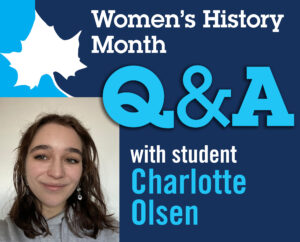
What does Women’s History Month mean to you?
As a female scholar, I am inspired to learn by the women from my past and the women from history who sought education in a world where one was often denied to them. Women’s History Month encourages all of us to step back and recognize the amazing reality we have in which we can learn and work and travel and live in ways that women throughout history never dreamt of. In every new generation of women contributing their perspectives and talents, we learn more about ourselves and the world around us in ways that alter concepts from science to gender roles. I am able to pursue a graduate degree because of the contributions of women who came before me and made that reality possible through their own struggles for equality and education. Remembering women’s history inspires my own work to understand the present through the study of the past, and to contribute something of my own to improve the lives of every woman across the globe.
If you could meet a woman leader, who would it be and why? What would you ask?
If I was able to, I would meet Mary Ellingson, a University of Evansville archaeologist and professor whose work in Ancient Greek terracotta figures was the first to examine miniature statuary figures in a domestic context rather than in temples. Her work was groundbreaking in the Classical field but due to her decision to have children in addition to the outbreak of World War II, Ellingson’s supervisory professor stole her work and published it under his name. The plagiarism went undiscovered until 2014. Ellingson’s seminal work influenced generations of archaeological practice following its publication under the wrong name and her contributions to the historical narrative altered the modern study of Ancient Greek life and religion. In addition to scholarly contributions, Ellingson managed an entire archaeological excavation composed of workmen, scholars, and researchers. As a student of Ancient History and Religion, her discoveries directly influence my own understanding and scholarship in the field. I would ask her how she managed the balance between her scholarly contributions and the undercurrent of masculinity and elitism in her field. It must have felt impossible to continue her work following a betrayal by her mentor and advisor, yet Ellingson continued on to work as a professor until her retirement in the 1970s, doubtlessly inspiring a great number of female scholars to pursue archaeology. Ellingson’s leadership lives on in the women studying Ancient History today, and I hope to carry her influence into the contemporary world as one of the scholars who utilizes their intellectual talents in order to contribute to our understanding of the past. The study of the past defines the future; Ellingson’s silent contributions to archaeology demonstrate its importance.
